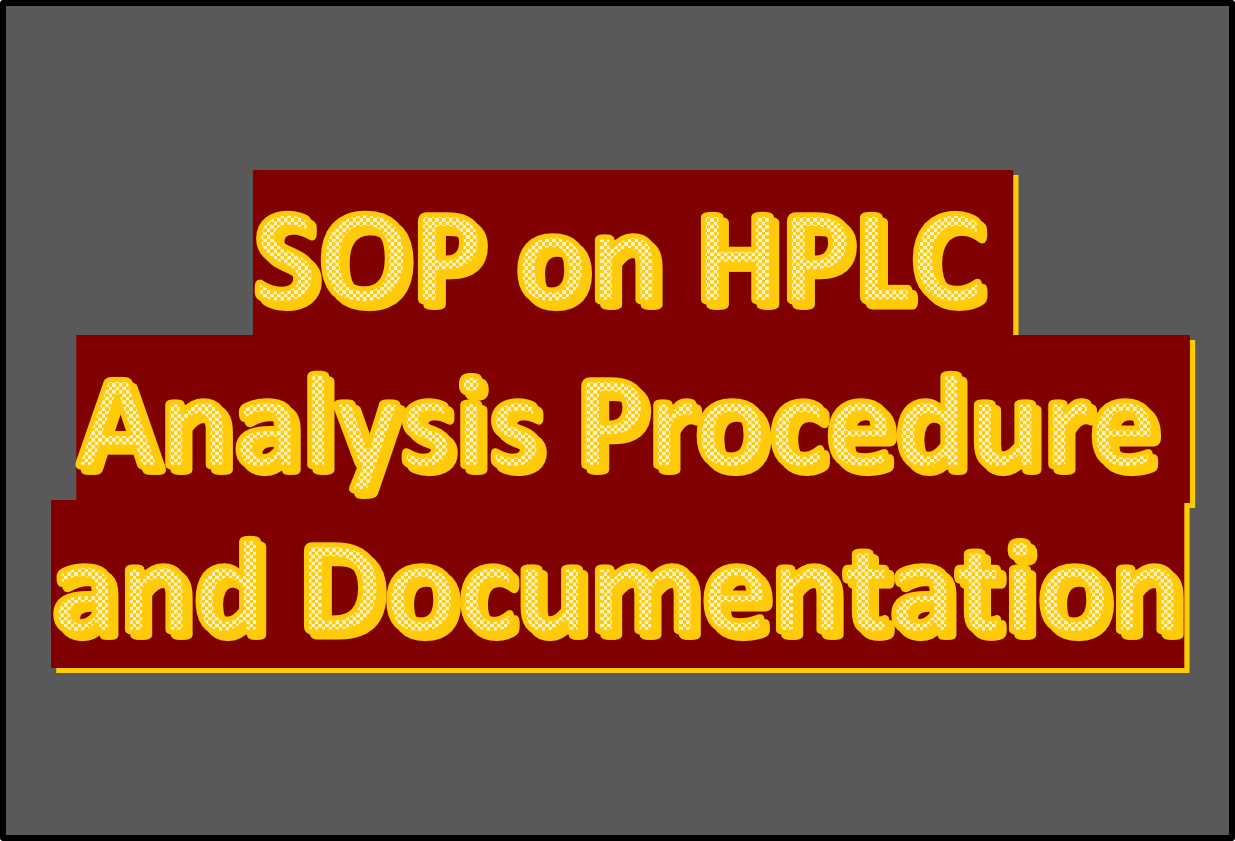SOP on HPLC Analysis Procedure and Documentation

HPLC Analysis
This article describes about (Standard Operating procedure) SOP on HPLC Analysis Procedure and Documentation in laboratories of Pharmaceutical Industry.
SOP on HPLC Analysis Procedure and Documentation
I. Purpose & Scope:
- To provide a general methodology to be followed while HPLC analysis and its documentation during analysis of drug product in Quality control laboratory of pharmaceutical industry
- Applicable to all personnel who are working in Quality control laboratory.
II. Responsibilities:
- All Quality Control and related personnel shall be responsible to follow and implement this SOP.
III : Introduction and Procedural Part :
1) PRECAUTIONS :
- Use always HPLC grade solvents and high purity chemicals (AR / LR grade) for preparing mobile phase and diluents.
- Filter and degas all mobile phase / solvents/ water prior to use as per specified STP and requirements.
- Avoid usage of column when back pressure is above 4000 psi.
- Increase the flow rate in small increments and decrements of 0.1ml/minute.
- If there is a shoot up of backpressure of column, reverse flush the column.
- Filter all the solutions before injection to HPLC system.
2) MOBILE PHASE PREPARATION:
- The mobile phase shall be prepared as per the composition and pH described in the procedure specified.
- Details like weight of the buffer(s), Balance no., observed pH, pH meter no., etc. for the mobile phase shall be recorded in the preparation entry register, record of analysis sheet and respective log books.
- The mobile phase shall not be used beyond 48 hours of its date of preparation.
- The mobile phase shall be discarded if any haziness or precipitation is found upon visual examination.
3) RESOLUTION SOLUTION:
- In cases where the resolution solution required for system suitability is to be stored for longer duration it shall be assigned a shelf life based on the following in HPLC analysis.
- The resolution solution shall meet all the system suitability parameters as required by the respective control procedure on each day of the study.
- For the main analyte peak the fall in area count on the day of preparation and at the end of the shelf life shall not exceed 20% with respect to the initial area count.
- For the impurity peak the fall in area count on the day of preparation and at the end of the shelf life shall not exceed 50% with respect to the initial area count.
4) STANDARD AND SAMPLE PREPARATION:
- The standard and sample preparation shall be made as per the specified procedure, taking into consideration the analyte stability & storage requirement in HPLC analysis.
5) ANALYSIS :
- The system suitability shall be established as per the control procedure, before proceeding with the analysis.
- Injection sequence to be followed shall be as per the control procedure. The following injection sequence may be used as per guideline.
- Blank –> System Suitability (or System Suit. –>Blank)–>Placebo (if required)–>Impurity Standard (if applicable)->Standards—>Samples —> Bracketing standards (Intermittent suitability).
- The system suitability (once established) shall be valid for a maximum period of 24 hours. After about every 24 hours (from the time when first system suitability is established) the intermittent demonstration of system suitability shall be done.
- The system suitability shall be demonstrated after every 24 hours (after the completion of the running sample), throughout the run, in the following manner For HPLC analysis, after about every 24 hours, standard solution shall be injected.
- The RSD of injection shall be as per the acceptance criteria stated in control procedure Where control procedure requires use of more than one concentration of standard, the standard with the lowest concentration shall be used for demonstration of intermittent system precision
6) ENDING OF ANALYSIS:
- All the HPLC analysis shall end with injection of standard solution (Bracketing standard) for evaluation of intermittent suitability. RSD shall meet as stated in respective control procedure.
7) SYSTEM SUITABILITY CRITERIA:
- In HPLC analysis system suitability shall be established as per the criteria in the control procedure. In case of assay analysis where “replicate injection” word mentioned in such case six injection of standard shall be made.
8) RECORDING CHROMATOGRAMS:
- In HPLC Analysis all chromatograms before establishment of system suitability and up to entire run shall be recorded and documented. Appropriate remarks (if required) shall be recorded on these by the Analyst/Supervisor.
- In case where the chromatogram needs disregarding, the analyst shall show it to the Supervisor/QC Manager for review and approval.
- The disregarded chromatogram shall be checked and certified by Supervisor/QC Manager.
- The chromatograms which are disregarded and not considered for calculations shall be marked as “DISREGARDED”. The reasons for disregarding the chromatogram could be variation in area count/ inconsistent area, faulty integration, abnormal drift in baseline, ghost peak or any other reason.
- Processing of chromatograms Blank /diluent / standard and sample shall be processed using the same processing parameters, When ever common blank / diluent is used for Related substances then blank / diluent shall be reprocess using related substances integration parameters.
- The analyst performing the analysis shall assign the reason of disregarding a chromatogram on the chromatogram itself. The disregarded chromatogram shall be filed along with the test chromatograms.
- Reprocessing of chromatograms, if necessary, at a later date/time shall be documented with reason(s) for reprocessing and certified by the QA Manager.
The entire record of chromatograms shall be part of the worksheet.
9) CALCULATIONS:
- The calculations shall be performed as per the respective STP. For HPLC analysis all calculations shall be done as per the area count / values obtained for the standard injected in the beginning. Area counts of in-between injections of standard shall not be considered for calculations.

